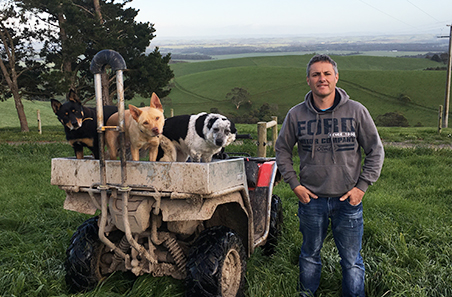0408 317 786
Pat Cleary
0428 592 692
Dhugald McDowell
0420 895 068
Jon Brewer
0408 816 953
Charlotte Freer
27 January 2017
 SNAPSHOT: Shane and Claire Harris
SNAPSHOT: Shane and Claire Harris
Location: Dumbalk North, 25km south-east of Leongatha, South Gippsland, Victoria
Area: 810ha (owned and leased)
Enterprise: Angus and prime lamb breeding and cattle trading
Livestock: 2,000 cattle (600 breeders, 1,400 trade stock), 1,600 ewes, 2,000 lambs
Pasture: Ryegrass and clover
Soil: Red, grey clay and sand peat
Rainfall: 1,075mm
Weaning cattle using advanced training techniques may take time and commitment, but South Gippsland producer Shane Harris is convinced it produces the best results.
Shane and his wife Claire, of ‘Harris Farms’, took part in an MLA-supported on-farm weaning trial that compared techniques to see which were best at quietening cattle and reducing weight loss.
Claire, who is also an Agriculture Victoria beef industry extension officer, was involved in the experiment design and data collection.
Shane and Claire put 100 Angus weaners in the trial (divided into two groups of 50) and compared their traditional paddock weaning method with advanced training, a technique that relies on the use of well-trained dogs and a sound understanding of the concepts of pressure and relief.
They had previously favoured paddock weaning, as they felt it avoided some of the respiratory and pink eye issues sometimes encountered when confining cattle, but the trial proved otherwise.
Shane said at the end of the trial the two groups were "chalk and cheese".
“The paddock-weaned mob were left on good pasture and were basically untouched, while the advanced training mob were worked with dogs for half-an-hour to an hour each day,” he said.
“By the end, the paddock-weaned mob weighed about the same or slightly better, but they weren’t quiet at all.
“The advanced training mob, which was also moved through the yards and crush as part of their routine, were really quiet – you could almost touch them in the paddock.”
Shane said that ‘quietness’ was also reflected in flight speed data, with the advanced training mob recording slower times than the paddock-weaned mob after the first week.
Making changes
In the two years since the trial, Shane and Claire have embraced advanced training and now use their dogs for all their stock movements.
They have also moved away from injectable drenches to pour-ons, as they believe too many needles upset young stock.
“It’s really important that those first experiences with us are good experiences,” he said.
The heifer weaners from the trial have now had their first calves, and Shane is convinced that sound training at weaning sets the animal up for life.
“If we have to pull a heifer, we walk her down the road to the yards,” he said.
“The steers put on weight fast because they’re calm and, now word is getting out how quiet our cattle are, we’re getting more inquiry from buyers.”
Shane and Claire breed about 60 commercial bulls each year, based on Queensland and New Zealand bloodlines, with their focus on a more compact type.
“When people come to look at our bulls they’re really impressed with how easy they are to work with and their calmness,” Shane said.
“We’ve also applied the same principles to our sheep and we are seeing the same pleasing results.”
More information:
Shane and Claire Harris E:
We are constantly having to get our clients to redo or amend their vendor dec's!!!!!! It's frustrating and can cost the vendor big money if they're vendor dec is incorrect or fails to answer every question .
Description of cattle; put in the breed , the sex breakup , the description ie cow bull steer hfr stag etc, the total head number including the break up of different descriptions . Do not put their NLIS tag number!!! It's not applicable .
NLIS devices is the number of devices on the cattle!!
question 4 "has the owner stated above owned these cattle since their birth" - it's pretty simple either yes or no-not both, if it's no put the lowest time in ie A- under two months, B 2-6 months etc
Question 9 put Russian and Saudi eligible. Russian eligible means that the cattle haven't had penicillin /antibiotics in the last 110 days and Saudi eligible means that the cattle have never in their life been fed animal fats . If applicable add that the cattle have never been treated antibiotics .